Comparative Analysis: Post-operative Nursing Care Report - NUR2226
VerifiedAdded on 2023/01/19
|6
|967
|74
Report
AI Summary
This report analyzes post-operative nursing care priorities for a patient named Erica Gardner, focusing on essential aspects such as pain management, vital signs monitoring, post-anesthesia care, and wound assessment. The report outlines the rationale behind each nursing intervention, including pain assessment using a 0-10 scale, monitoring vital signs to detect potential deterioration, assessing the patient's recovery from anesthesia, and monitoring the surgical site for infection. It also addresses potential post-operative complications like abdominal distension, paralytic ileus, and hemorrhage, detailing their management strategies. The report emphasizes the importance of early mobilization, managing fluid and electrolyte imbalances, and preventing infections. The assignment also requires a comparative analysis, identifying similarities and differences between the student's response and an expert response, along with reflections on learning and the impact on future practice.
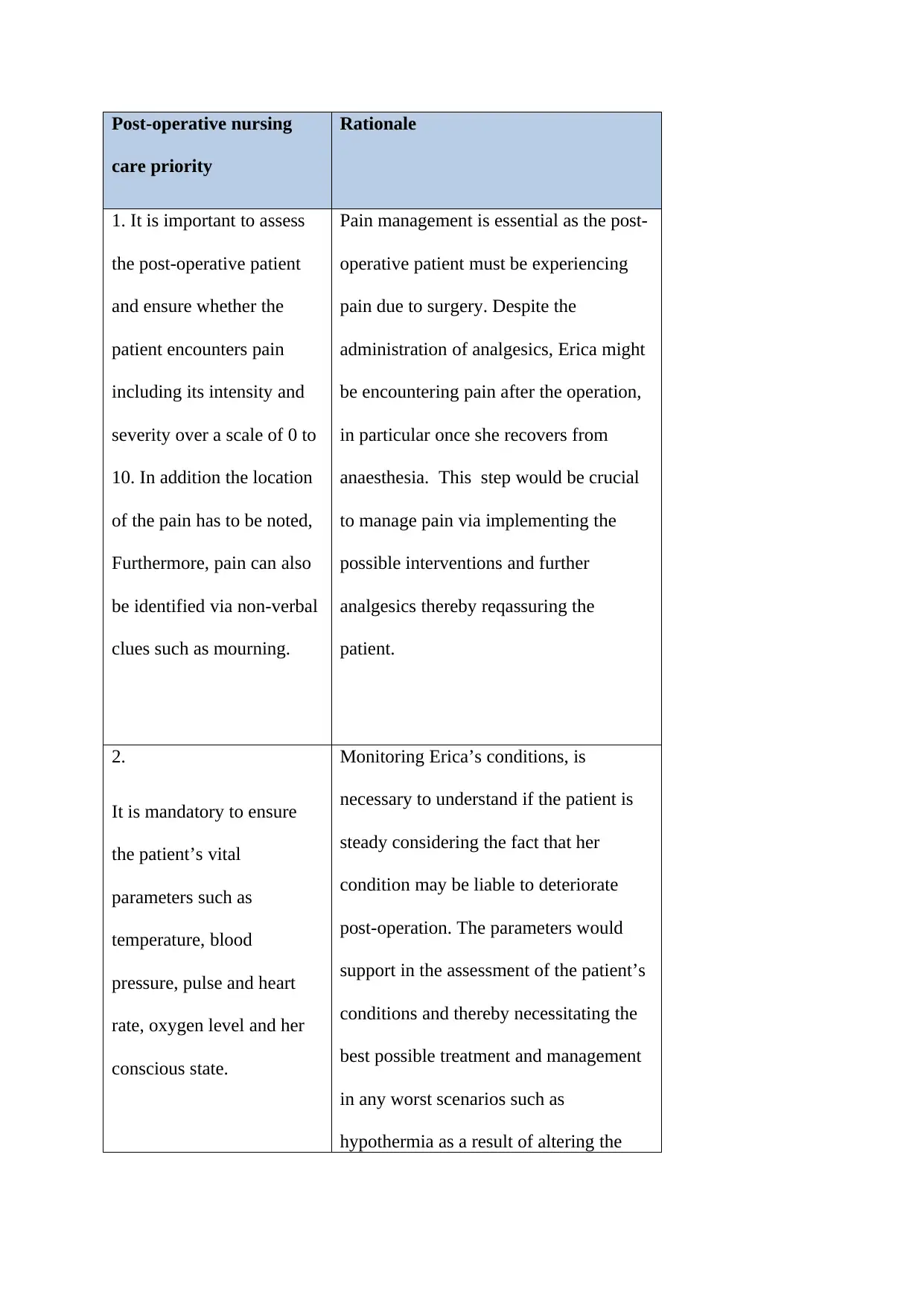
Post-operative nursing
care priority
Rationale
1. It is important to assess
the post-operative patient
and ensure whether the
patient encounters pain
including its intensity and
severity over a scale of 0 to
10. In addition the location
of the pain has to be noted,
Furthermore, pain can also
be identified via non-verbal
clues such as mourning.
Pain management is essential as the post-
operative patient must be experiencing
pain due to surgery. Despite the
administration of analgesics, Erica might
be encountering pain after the operation,
in particular once she recovers from
anaesthesia. This step would be crucial
to manage pain via implementing the
possible interventions and further
analgesics thereby reqassuring the
patient.
2.
It is mandatory to ensure
the patient’s vital
parameters such as
temperature, blood
pressure, pulse and heart
rate, oxygen level and her
conscious state.
Monitoring Erica’s conditions, is
necessary to understand if the patient is
steady considering the fact that her
condition may be liable to deteriorate
post-operation. The parameters would
support in the assessment of the patient’s
conditions and thereby necessitating the
best possible treatment and management
in any worst scenarios such as
hypothermia as a result of altering the
care priority
Rationale
1. It is important to assess
the post-operative patient
and ensure whether the
patient encounters pain
including its intensity and
severity over a scale of 0 to
10. In addition the location
of the pain has to be noted,
Furthermore, pain can also
be identified via non-verbal
clues such as mourning.
Pain management is essential as the post-
operative patient must be experiencing
pain due to surgery. Despite the
administration of analgesics, Erica might
be encountering pain after the operation,
in particular once she recovers from
anaesthesia. This step would be crucial
to manage pain via implementing the
possible interventions and further
analgesics thereby reqassuring the
patient.
2.
It is mandatory to ensure
the patient’s vital
parameters such as
temperature, blood
pressure, pulse and heart
rate, oxygen level and her
conscious state.
Monitoring Erica’s conditions, is
necessary to understand if the patient is
steady considering the fact that her
condition may be liable to deteriorate
post-operation. The parameters would
support in the assessment of the patient’s
conditions and thereby necessitating the
best possible treatment and management
in any worst scenarios such as
hypothermia as a result of altering the
Paraphrase This Document
Need a fresh take? Get an instant paraphrase of this document with our AI Paraphraser
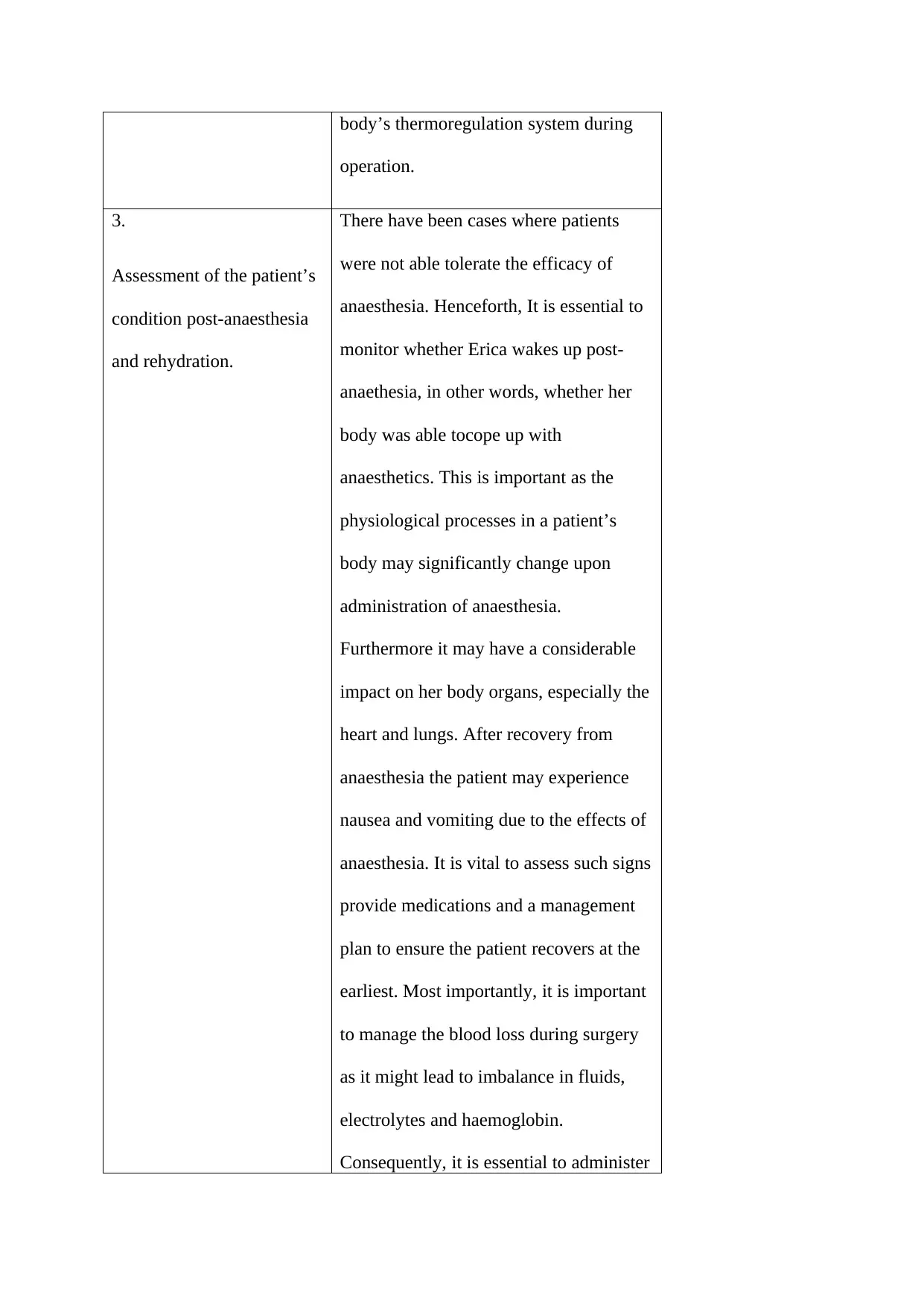
body’s thermoregulation system during
operation.
3.
Assessment of the patient’s
condition post-anaesthesia
and rehydration.
There have been cases where patients
were not able tolerate the efficacy of
anaesthesia. Henceforth, It is essential to
monitor whether Erica wakes up post-
anaethesia, in other words, whether her
body was able tocope up with
anaesthetics. This is important as the
physiological processes in a patient’s
body may significantly change upon
administration of anaesthesia.
Furthermore it may have a considerable
impact on her body organs, especially the
heart and lungs. After recovery from
anaesthesia the patient may experience
nausea and vomiting due to the effects of
anaesthesia. It is vital to assess such signs
provide medications and a management
plan to ensure the patient recovers at the
earliest. Most importantly, it is important
to manage the blood loss during surgery
as it might lead to imbalance in fluids,
electrolytes and haemoglobin.
Consequently, it is essential to administer
operation.
3.
Assessment of the patient’s
condition post-anaesthesia
and rehydration.
There have been cases where patients
were not able tolerate the efficacy of
anaesthesia. Henceforth, It is essential to
monitor whether Erica wakes up post-
anaethesia, in other words, whether her
body was able tocope up with
anaesthetics. This is important as the
physiological processes in a patient’s
body may significantly change upon
administration of anaesthesia.
Furthermore it may have a considerable
impact on her body organs, especially the
heart and lungs. After recovery from
anaesthesia the patient may experience
nausea and vomiting due to the effects of
anaesthesia. It is vital to assess such signs
provide medications and a management
plan to ensure the patient recovers at the
earliest. Most importantly, it is important
to manage the blood loss during surgery
as it might lead to imbalance in fluids,
electrolytes and haemoglobin.
Consequently, it is essential to administer
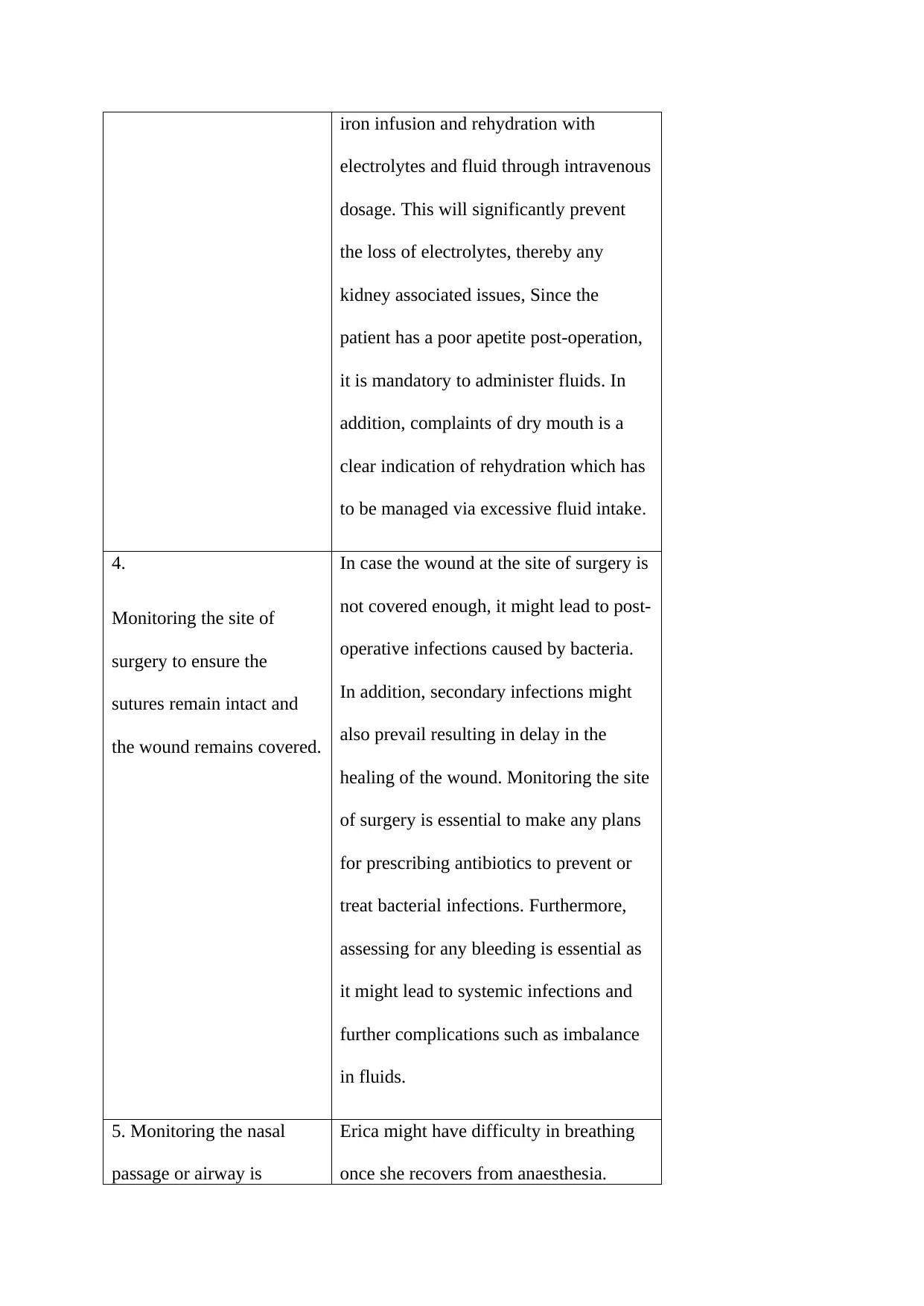
iron infusion and rehydration with
electrolytes and fluid through intravenous
dosage. This will significantly prevent
the loss of electrolytes, thereby any
kidney associated issues, Since the
patient has a poor apetite post-operation,
it is mandatory to administer fluids. In
addition, complaints of dry mouth is a
clear indication of rehydration which has
to be managed via excessive fluid intake.
4.
Monitoring the site of
surgery to ensure the
sutures remain intact and
the wound remains covered.
In case the wound at the site of surgery is
not covered enough, it might lead to post-
operative infections caused by bacteria.
In addition, secondary infections might
also prevail resulting in delay in the
healing of the wound. Monitoring the site
of surgery is essential to make any plans
for prescribing antibiotics to prevent or
treat bacterial infections. Furthermore,
assessing for any bleeding is essential as
it might lead to systemic infections and
further complications such as imbalance
in fluids.
5. Monitoring the nasal
passage or airway is
Erica might have difficulty in breathing
once she recovers from anaesthesia.
electrolytes and fluid through intravenous
dosage. This will significantly prevent
the loss of electrolytes, thereby any
kidney associated issues, Since the
patient has a poor apetite post-operation,
it is mandatory to administer fluids. In
addition, complaints of dry mouth is a
clear indication of rehydration which has
to be managed via excessive fluid intake.
4.
Monitoring the site of
surgery to ensure the
sutures remain intact and
the wound remains covered.
In case the wound at the site of surgery is
not covered enough, it might lead to post-
operative infections caused by bacteria.
In addition, secondary infections might
also prevail resulting in delay in the
healing of the wound. Monitoring the site
of surgery is essential to make any plans
for prescribing antibiotics to prevent or
treat bacterial infections. Furthermore,
assessing for any bleeding is essential as
it might lead to systemic infections and
further complications such as imbalance
in fluids.
5. Monitoring the nasal
passage or airway is
Erica might have difficulty in breathing
once she recovers from anaesthesia.
⊘ This is a preview!⊘
Do you want full access?
Subscribe today to unlock all pages.

Trusted by 1+ million students worldwide
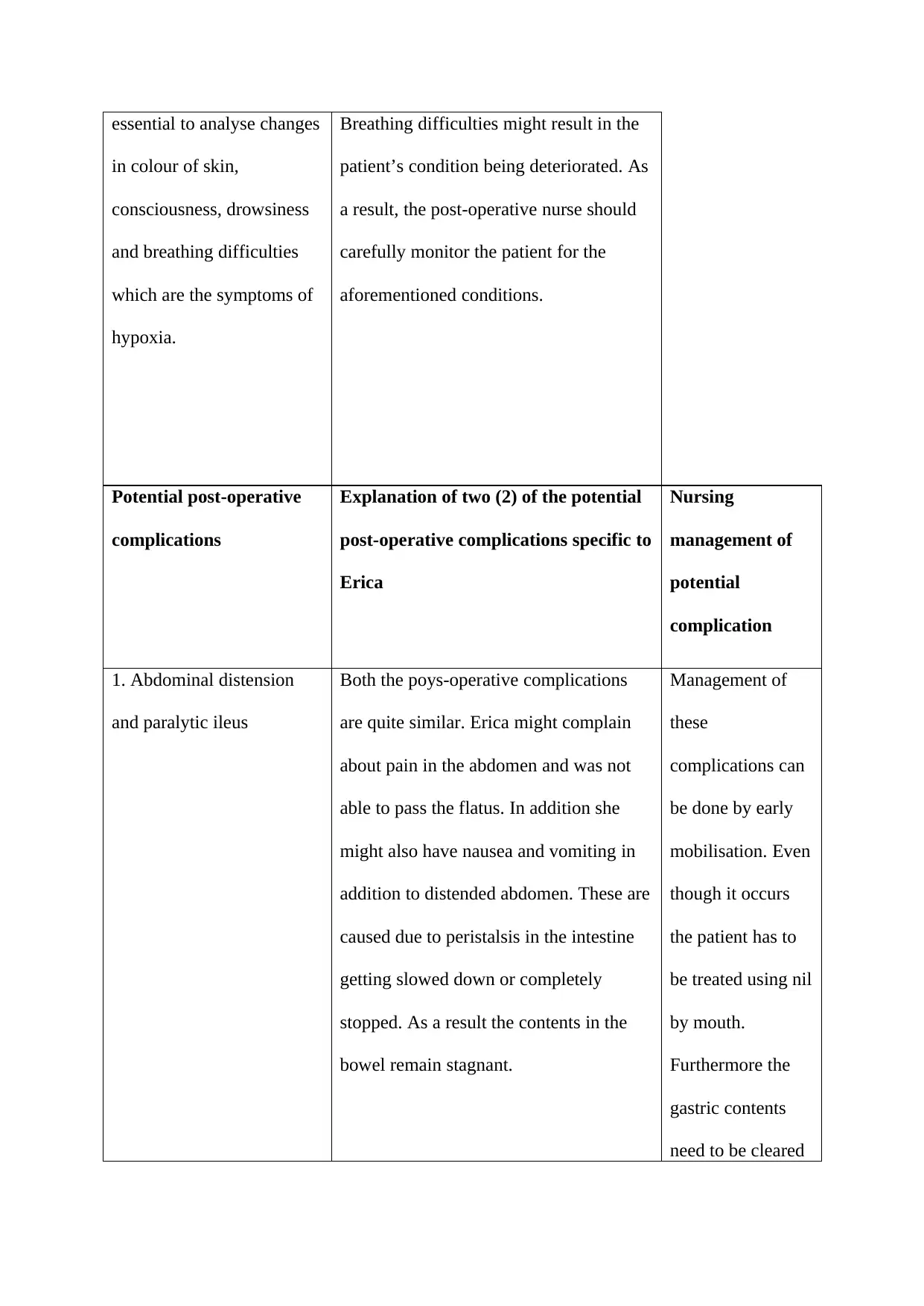
essential to analyse changes
in colour of skin,
consciousness, drowsiness
and breathing difficulties
which are the symptoms of
hypoxia.
Breathing difficulties might result in the
patient’s condition being deteriorated. As
a result, the post-operative nurse should
carefully monitor the patient for the
aforementioned conditions.
Potential post-operative
complications
Explanation of two (2) of the potential
post-operative complications specific to
Erica
Nursing
management of
potential
complication
1. Abdominal distension
and paralytic ileus
Both the poys-operative complications
are quite similar. Erica might complain
about pain in the abdomen and was not
able to pass the flatus. In addition she
might also have nausea and vomiting in
addition to distended abdomen. These are
caused due to peristalsis in the intestine
getting slowed down or completely
stopped. As a result the contents in the
bowel remain stagnant.
Management of
these
complications can
be done by early
mobilisation. Even
though it occurs
the patient has to
be treated using nil
by mouth.
Furthermore the
gastric contents
need to be cleared
in colour of skin,
consciousness, drowsiness
and breathing difficulties
which are the symptoms of
hypoxia.
Breathing difficulties might result in the
patient’s condition being deteriorated. As
a result, the post-operative nurse should
carefully monitor the patient for the
aforementioned conditions.
Potential post-operative
complications
Explanation of two (2) of the potential
post-operative complications specific to
Erica
Nursing
management of
potential
complication
1. Abdominal distension
and paralytic ileus
Both the poys-operative complications
are quite similar. Erica might complain
about pain in the abdomen and was not
able to pass the flatus. In addition she
might also have nausea and vomiting in
addition to distended abdomen. These are
caused due to peristalsis in the intestine
getting slowed down or completely
stopped. As a result the contents in the
bowel remain stagnant.
Management of
these
complications can
be done by early
mobilisation. Even
though it occurs
the patient has to
be treated using nil
by mouth.
Furthermore the
gastric contents
need to be cleared
Paraphrase This Document
Need a fresh take? Get an instant paraphrase of this document with our AI Paraphraser
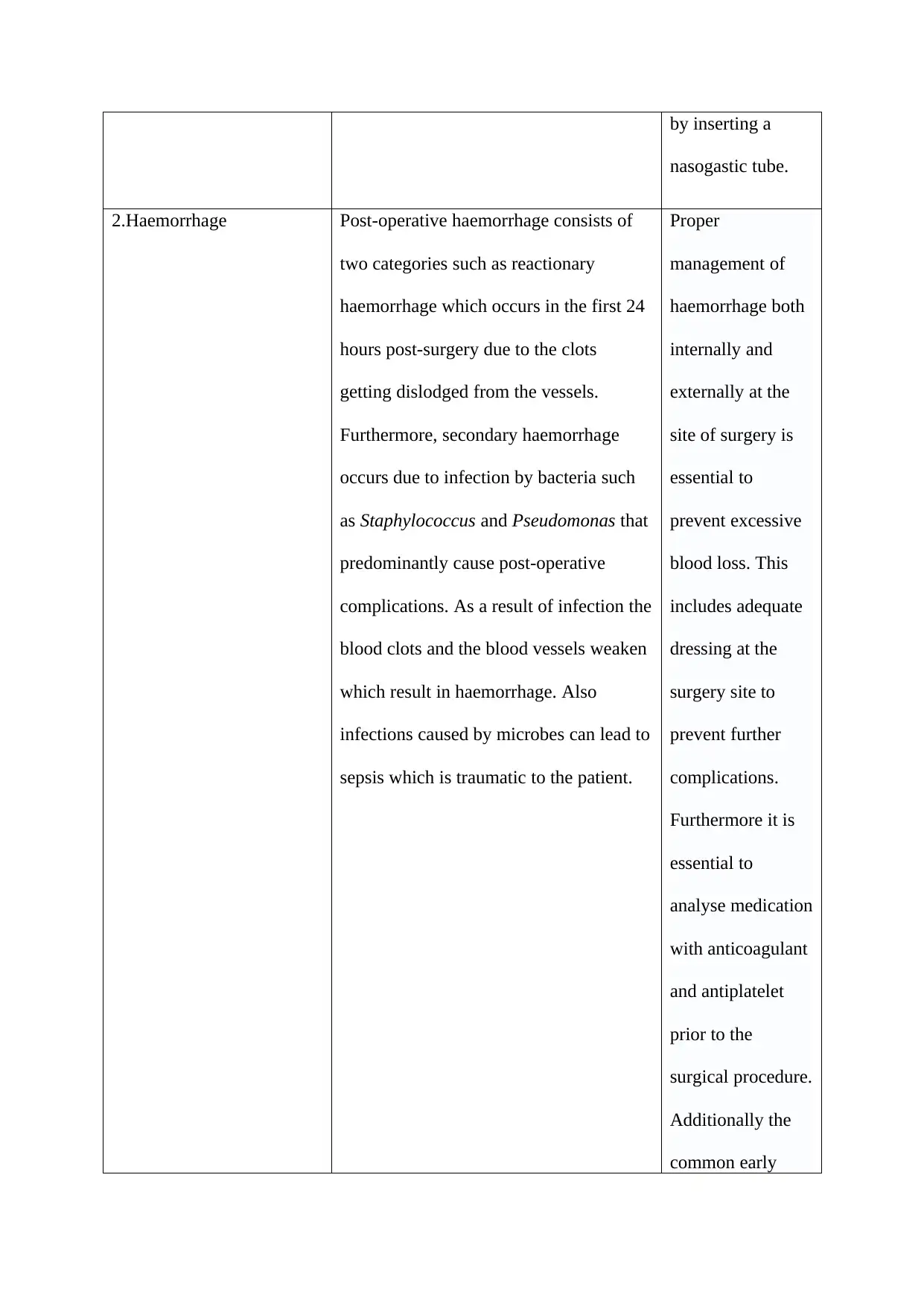
by inserting a
nasogastic tube.
2.Haemorrhage Post-operative haemorrhage consists of
two categories such as reactionary
haemorrhage which occurs in the first 24
hours post-surgery due to the clots
getting dislodged from the vessels.
Furthermore, secondary haemorrhage
occurs due to infection by bacteria such
as Staphylococcus and Pseudomonas that
predominantly cause post-operative
complications. As a result of infection the
blood clots and the blood vessels weaken
which result in haemorrhage. Also
infections caused by microbes can lead to
sepsis which is traumatic to the patient.
Proper
management of
haemorrhage both
internally and
externally at the
site of surgery is
essential to
prevent excessive
blood loss. This
includes adequate
dressing at the
surgery site to
prevent further
complications.
Furthermore it is
essential to
analyse medication
with anticoagulant
and antiplatelet
prior to the
surgical procedure.
Additionally the
common early
nasogastic tube.
2.Haemorrhage Post-operative haemorrhage consists of
two categories such as reactionary
haemorrhage which occurs in the first 24
hours post-surgery due to the clots
getting dislodged from the vessels.
Furthermore, secondary haemorrhage
occurs due to infection by bacteria such
as Staphylococcus and Pseudomonas that
predominantly cause post-operative
complications. As a result of infection the
blood clots and the blood vessels weaken
which result in haemorrhage. Also
infections caused by microbes can lead to
sepsis which is traumatic to the patient.
Proper
management of
haemorrhage both
internally and
externally at the
site of surgery is
essential to
prevent excessive
blood loss. This
includes adequate
dressing at the
surgery site to
prevent further
complications.
Furthermore it is
essential to
analyse medication
with anticoagulant
and antiplatelet
prior to the
surgical procedure.
Additionally the
common early
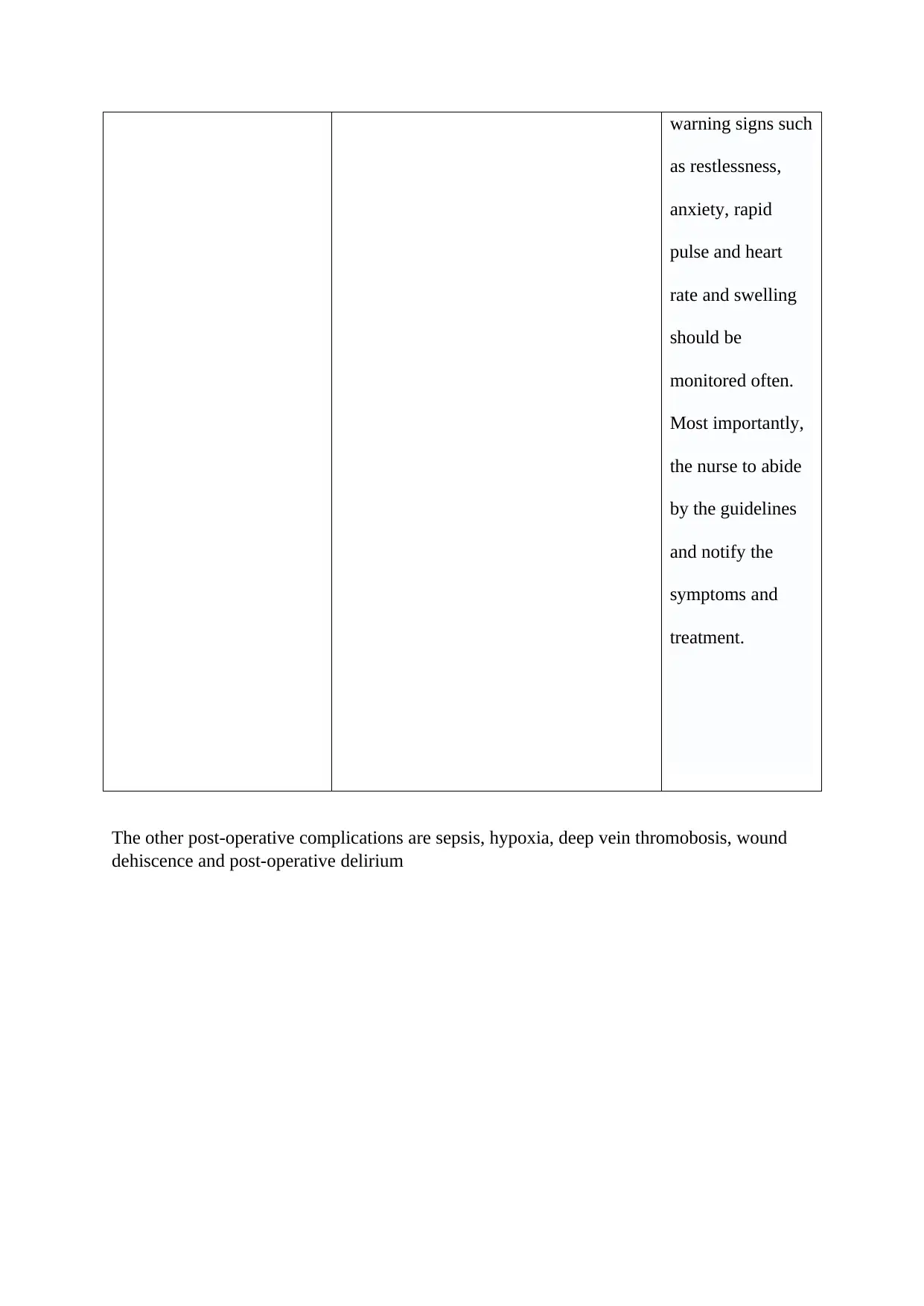
warning signs such
as restlessness,
anxiety, rapid
pulse and heart
rate and swelling
should be
monitored often.
Most importantly,
the nurse to abide
by the guidelines
and notify the
symptoms and
treatment.
The other post-operative complications are sepsis, hypoxia, deep vein thromobosis, wound
dehiscence and post-operative delirium
as restlessness,
anxiety, rapid
pulse and heart
rate and swelling
should be
monitored often.
Most importantly,
the nurse to abide
by the guidelines
and notify the
symptoms and
treatment.
The other post-operative complications are sepsis, hypoxia, deep vein thromobosis, wound
dehiscence and post-operative delirium
⊘ This is a preview!⊘
Do you want full access?
Subscribe today to unlock all pages.

Trusted by 1+ million students worldwide
1 out of 6
Related Documents
Your All-in-One AI-Powered Toolkit for Academic Success.
+13062052269
info@desklib.com
Available 24*7 on WhatsApp / Email
![[object Object]](/_next/static/media/star-bottom.7253800d.svg)
Unlock your academic potential
Copyright © 2020–2025 A2Z Services. All Rights Reserved. Developed and managed by ZUCOL.





